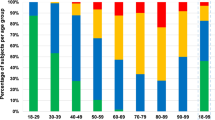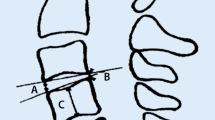Abstract
Objective
To study the relationship of upper thoracic spine degenerative disc contour changes on MR imaging in patients with neck pain. The relation between upper thoracic and cervical spine degenerative disc disease is not well established.
Design and patients
One hundred and fifty-six patients referred with cervical pain were studied. There were 73 women and 77 men with a mean age of 48.6±14.6 years (range, 19 to 83 years). All MR studies were performed with a large 23-cm FOV covering at least from the body of T4 to the clivus. Discs were coded as normal, protrusion/bulge or extrusion.
Results
Degenerative thoracic disc contour changes were observed in 13.4% of patients with cervical pain. T2–3 was the most commonly affected level of the upper thoracic spine, with 15 bulge/protrusions and one extrusion. Upper degenerative thoracic disc contour changes presented in older patients than the cervical levels (Student-Newman-Keuls test, P<0.001). Degenerative disc contour changes at the C7–T1, T1–2, T2–3 and T3–4 levels were significantly correlated (P=0.001), but unrelated to any other disc disease, patient’s gender or age. Degenerative cervical disc disease was closely related together (P<0.001), but not with any thoracic disc.
Conclusion
A statistically significant relation was found within the upper thoracic discs, reflecting common pathoanatomical changes. The absence of relation to cervical segments is probably due to differences in their pathomechanisms.


Similar content being viewed by others
References
Boden S, McCowin P, Davis D, Dina T, Mark A, Wiesel S. Abnormal magnetic-resonance scans of the cervical spine in asymptomatic subjects. A prospective investigation. J Bone Joint Surg [Am] 1990; 72-A:1178–1184.
Williams MP, Cherryman GR, Husband JE. Significance of thoracic disc herniation demonstrated by MR imaging. J Comp Assist Tomog 1989;13:211–214.
Matsumoto M, Fujimura Y, Suzuki N et al. MRI of cervical intervertebral discs in asymptomatic subjects. J Bone Joint Surg [Br] 1998; 80-B:19–24.
Boutin RD, Steinbach LS, Finnesey K. MR imaging of degenerative diseases in the cervical spine. MRI Clin N Am 2000; 8:471–489.
Awwad E, Martin D, Smith K, Baker B. Asymptomatic versus symptomatic herniated thoracic discs: their frequency and characteristics as detected by computed tomography after myelography. Neurosurgery 1991; 28:180–186.
Morgan H, Abood C. Disc herniation at T1–2. Report of four cases and literature review. J Neurosurg 1998; 88:148–150.
Shafaie F, Wippold F, Gado M, Pilgram T, Riew K. Comparison of computed tomography myelography and magnetic resonance imaging in the evaluation of cervical spondylotic myelopathy and radiculopathy. Spine 1999; 24:1781–1788.
Sengupta D, Kirollos R, Findlay G, Smith E, Pearson J, Pigott T. The value of MR imaging in differentiating between hard and soft cervical disc disease: a comparison with intraoperative findings. Eur Spine J 1999; 8:199–204.
Wood K, Garvey T, Gundry C, Heithoff K. Magnetic resonance imaging of the thoracic spine. Evaluation of asymptomatic individuals. J Bone Joint Surg [Am] 1995; 77-A:1631–1638.
Stillerman C, Chen T, Couldwell W, Zhang W, Weiss M. Experience in the surgical management of 82 symptomatic herniated thoracic discs and review of the literature. J Neurosurg 1998; 88:623–633.
Rosenbloom S. Thoracic disc disease and stenosis. Radiol Clin N Am 1991; 29:765–775.
Wood K, Blair J, Aepple C et al. The natural history of asymptomatic thoracic disc herniations. Spine 1997; 22:525–529.
Tani T, Yamamoto H, Kimura J. Cervical spondilotic myelopathy in elderly people: a high incidence of conduction block at C3–4 or C4–5. J Neurol Neurosurg Psychiatry 1999; 66:456–464.
Graf W, De Waele C, Vidal P. Functional anatomy of the head-neck movement system of quadrupedal and bipedal mammals. J Anat 1995; 186:55–74.
Nishizawa S, Yokoyama T, Yokota N, Kaneko M. High cervical disc lesiones in elderly patients-presentation and surgical approach. Acta Neurochir (Wien) 1999; 141:119–126.
An H, Wise J, Xu R. Anatomy of the cervicothoracic junction: a study of cadaveric dissection, cryomicrotomy and magnetic resonance imaging. J Spinal Dis 1999; 12:519–525.
Boyle J, Singer K, Milne N. Morphological survey of the cervicothoracic junctional region. Spine 1996; 21:544–548.
Arana E, Martí-Bonmatí L, Dosdá R, Mollá E. Concomitant lower thoracic spine disc disease in lumbar spine MR imaging studies. Eur Radiol 2002; 12:2794–2798.
Milette P, Fontaine S, Lepanto L, Cardinal E, Breton G. Differentianting lumbar disc protrusions, disc bulges, and discs with normal contour but abnormal signal intensity. Spine 1999; 24:44–53.
Haughton V. Point of view: Differentiating lumbar disc protrusions, disc bulges, and discs with normal contour but abnormal signal intensity. Spine 1999; 24:53
Epstein N, Epstein J, Carras R, Murthy V, Hyman R. Co-existing cervical and lumbar spinal stenosis: diagnosis and management. Neurosurgery 1984; 15:489–496.
Bentley P, Grigor C, McNally J, et al. Degenerative cervical disc disease causing cord compression in adults under 50. BMJ 2001; 322:414–415.
Boockvar J, Philips M, Telfeian A, O’Rourke D, Marcotte P. Results and risk factor for anterior cervicothoracic junction surgery. J Neurosurg: Spine 2001; 94:12–17.
Author information
Authors and Affiliations
Corresponding author
Additional information
This paper was presented at the 9th Scientific Meeting and Exhibition of the International Society for Magnetic Resonance in Medicine and the 18th Annual Meeting and Exhibition of the European Society for Magnetic Resonance in Medicine and Biology, which were held jointly in Glasgow, Scotland, UK, April 2001.
Rights and permissions
About this article
Cite this article
Arana, E., Martí-Bonmatí, L., Mollá, E. et al. Upper thoracic-spine disc degeneration in patients with cervical pain. Skeletal Radiol 33, 29–33 (2004). https://doi.org/10.1007/s00256-003-0699-9
Received:
Revised:
Accepted:
Published:
Issue Date:
DOI: https://doi.org/10.1007/s00256-003-0699-9




